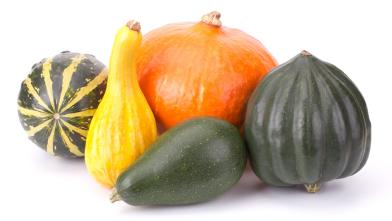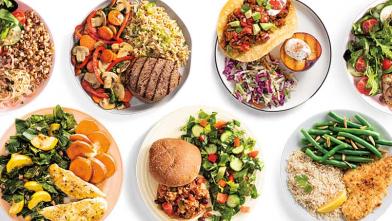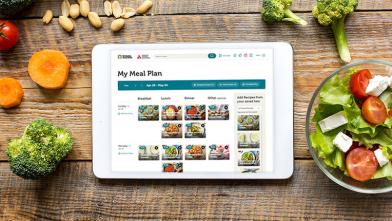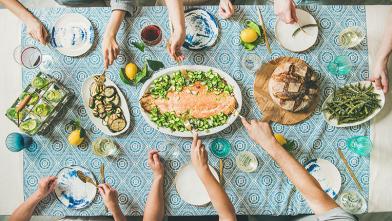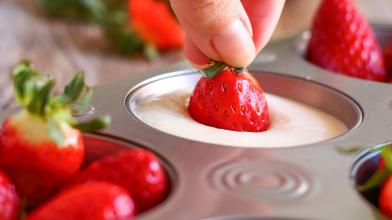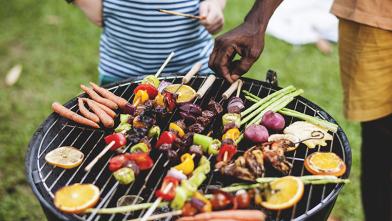Taking a vacation and travelling by car, rail, or plane may take you away from your regular routine and affect how you can follow your eating plan. But a little planning can go a long way to enjoy your vacation while still following your eating plan and managing diabetes.
Here are seven tips to get you started:
1. Bring a cooler and snacks for a road trip. Pack different types of snacks, like bite-size pieces of fresh non-starchy veggies (carrots, broccoli, celery, bell pepper); protein foods like hardboiled eggs, nuts, or low-fat string cheese; and quality carbohydrate foods like fruit, roasted chickpeas, whole grain crackers, or plain popcorn. Think of the Diabetes Plate as your guide for deciding what food to bring—one half of the plate filled with non-starchy vegetables, one quarter with lean protein and one quarter with quality carbs. When traveling, try to find a grocery store to pick up or restock healthy snacks.
2. Pack healthy shelf-stable snacks from home if you can’t keep a cooler with you. Use baggies or containers with measured portions of nuts, or peanut butter on whole grain bread or crackers. You can also bring dehydrated cheese, such as parmesan crisps, as a low-carb protein snack. These are also great ideas to bring with you if you are flying on an airplane or riding the train.
3. Look at menus before dining out. Restaurants at your vacation location may have menus available online that list ingredients or nutrition facts. By looking at the menu ahead of time, you will be more prepared and confident in making choices that fit your eating plan.
On the other hand, if you find yourself in a restaurant where the choices don’t exactly fit your eating plan, look for side dishes to complete your meal, eat smaller portions, or share your meal with someone you’re eating with.
Look for foods cooked in healthy ways by looking for words like “roasted,” “baked,” or “grilled.” Try to choose balanced meals that follow the Diabetes Plate—non-starchy vegetables to fill half of your plate, lean protein for one-quarter of the plate, and quality carbohydrate for the last quarter of the plate. This strategy will keep you satisfied and on track with your eating plan.
If you’re flying and your flight includes a meal, request a diabetes-friendly meal ahead of time. If you find yourself in the airport during mealtime, check the airport’s website to find out about food options in your terminal.
4. Think about your drinks. Water is your best beverage option to stay hydrated, especially if you are in the sun or active on your vacation. You can also choose zero-calorie drinks or fruit-infused water. Limit sugar-filled or alcoholic drinks because they will affect your blood glucose (blood sugar) levels.
5. Make the best carb choices you can. Choosing quality carbs that contain fiber or are combined with a protein or healthy fat. Foods that contain fiber, protein, or healthy fats will help slow how carbs affect your blood glucose (blood sugar) level. Don’t be afraid to ask your waiter for help or to modify a dish for you! For example, ask for your chicken sandwich to be served on a whole grain bun or on a leafy green, instead of white bread, and swap French fries for grilled or steamed veggies or a side salad served with light dressing on the side.
6. Read nutrition labels. Look at the percent Daily Value (%DV) on the food label for each nutrient. Aim for less than 10% DV for nutrients you want to limit—including sodium, saturated fat, and added sugar—and aim for 10% DV or higher for nutrients you want to get more of—like fiber, vitamin D, calcium, and iron.
7. Check the regional foods of places you’ve never been. Whether you are traveling locally or out of the country, take advantage of online travel blogs for dining tips, especially if visiting countries with a language you don’t know. Knowing what to expect and having the names of non-starchy vegetable- and protein-forward dishes and where you want to eat can help you plan your meals. And you can look forward to trying new foods in ways that fit your eating plan!
Have Fun!
Vacations are a time to disconnect, unwind, relax, and have fun. Do a little extra planning ahead of time and you’ll be able to follow your eating plan and reach your health goals even while you travel.
Want more articles like this? Sign up for Diabetes Food Hub’s e-newsletter for diabetes-friendly articles, ideas, and recipes from the ADA’s Nutrition & Wellness team delivered to your inbox every month.







